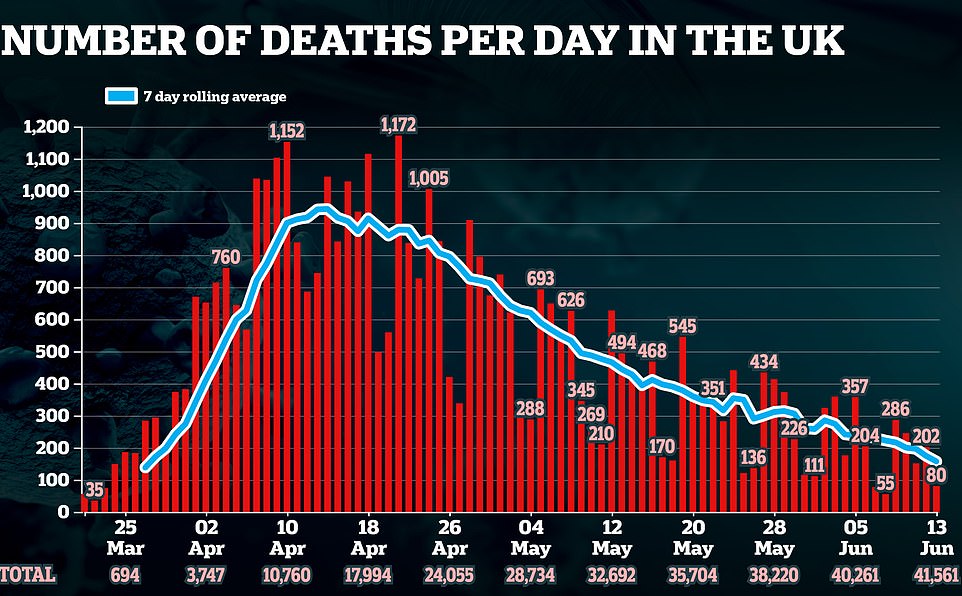Britain has today recorded 80 more coronavirus deaths, taking the total number of victims to 41,561 in another sign the epidemic is fading.
The preliminary figure is calculated by adding up coronavirus deaths across the UK, but it does not take into account fatalities in care homes in England.
It means that the total figure announced later today by the Department of Health has the potential to be significantly higher.
Broken down, the total of 80 includes 67 more deaths in hospitals in England, six in total across Wales, five in Scotland and two in Northern Ireland.
Despite the continued downward trend in deaths, the reproduction rate of the virus could be as high as 1.1 in the South West of England, meaning the virus is on the brink of surging out of control in the rural region.
Officials at the Government Office of Science, which is headed by Sir Patrick Vallance, confirmed that the R rate in the South West is now somewhere between 0.8 and 1.1, which is a higher estimate than any other part of the UK. The R rate for Britain as a whole, however, has not changed in the past week and remains between 0.7 and 0.9.
The South West is the only region which could have a value higher than one, the dreaded point at which each infected patient starts to infect more than one other person and an outbreak starts to grow again. Last week the region’s estimate was 0.8-1.0, showing it has risen in the past seven days.
East of England currently has the lowest estimate, with its 0.7-0.9 making it the only region where the figure is definitely below 1.
In other coronavirus developments today:
- SAGE scientists have told ministers that pubs, restaurants and shops can ignore the two-metre rule when they reopen but should ban singing and shouting because it spreads the disease;
- Boris Johnson has called on Britons to head to the High Street and kick-start the flagging economy when transformed stores reopen on Manic Monday;
- Covid may trigger the onset of diabetes in healthy people, 17 experts have warned in the in the New England Journal of Medicine;
- One in five hospital coronavirus patients caught killer bug on a hospital ward, the Government scientists as medics are told to stop ‘congregating’ during their breaks as it spreads the virus;
- Neuroscientists have warned that lockdown is putting teenagers at risk of future mental health problems because their developing brains need face-to-face social interaction to build psychological resilience.
The Government Office for Science report yesterday estimated that the R in London – formerly the UK’s coronavirus epicentre, is between 0.8 and 1 along with, the Midlands, the North West and the South East.
Figures suggest the R sits between 0.7 and 1 in the North East and around 0.7 and 0.9 in the East of England. Officials have urged caution about drawing hard and fast conclusions about R value estimates.
They say that predicting the R with any real accuracy will become increasingly difficult as the crisis continues to peter out in the UK. The fewer infected patients there are, the greater the margin for error, especially when looking at specific regions of the UK.
For example, if there are only 10 cases and one of them infects three people, it would push the R rate up significantly and skew the average. From next week the Government will publish the growth rates for regions based on raw infection data.
The R rate has been crucial in guiding the Government’s gradual relaxation of lockdown measures. The R was believed to have been between three and four at the height of the crisis and getting it below one was paramount to loosening restrictions at all.
Reacting to the development, Matt Keeling, professor of populations and disease at the University of Warwick, said: ‘All the ranges are similar and overlapping, so we cannot say that any one region is worse than any other region.
‘All the ranges are closer to the critical threshold of R=1 than we would ideally like to see – which means that the epidemic is declining relatively slowly.
‘This also means we haven’t got much wiggle room for additional relaxation of social distancing measures.
‘As the number of cases becomes smaller in many regions, these predictions will become more uncertain and more biased by small localised outbreaks.
‘There is still some uncertainty in these values, which are influenced by the three interacting outbreaks in hospitals, in care homes and in the community.’
Health Secretary Matt Hancock admitted last week that localised lockdowns could be introduced if some parts of the country continued to be hit harder than others.
‘You’re right that the R is closer to one in the South West and in the North West, the advice from SAGE is that R is below one in all regions,’ he said.
‘However, we want to increasingly have an approach in tackling local lockdowns where we spot a flare-up.’
